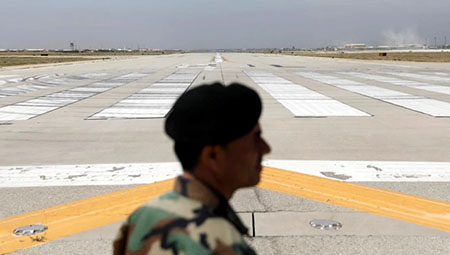by WorldTribune Staff, August 22, 2021
Team Biden made a catastrophic error in giving up Bagram Air Base, which was a key in the Trump administration’s plan for withdrawal from Afghanistan, former National Security Council Senior Director Kash Patel said.
With U.S. citizens and equipment still in Afghanistan, Team Biden surrendered the strategically key base last month.

Afghan military officials said Team Biden left by shutting off the electricity and slipping away in the night without notifying the base’s new Afghan commander, who discovered the Americans’ departure more than two hours after they left.
“We (heard) some rumor that the Americans had left Bagram … and finally by seven o’clock in the morning, we understood that it was confirmed that they had already left Bagram,” Gen. Mir Asadullah Kohistani, Bagram’s new commander said.
“We would not have ever relinquished control of Bagram Airfield, because that is our command and control node for the entire region,” Patel said Thursday on the John Solomon Reports podcast. “And that’s where we would fly in and out securely.” As a former close aide to California Republican Rep. Devin Nunes on the House Intelligence Committee, Patel emerged as a rare U.S. official former President Trump could trust to coordinate with the Intelligence Community.
The Trump plan included retaining control of Bagram Air Base until all Americans were withdrawn from Afghanistan. Bagram has two runways and other facilities that safely can handle significant amounts of traffic and also host a large population. Kabul airport has just one runway.
“No one in their right mind would have closed Bagram Air Base while leaving behind thousands of civilians,” Arkansas GOP senator and Afghanistan war veteran Tom Cotton tweeted.
Gen. Mark Milley, chairman of the Joint Chiefs of Staff, said on Wednesday: “If we were to keep both Bagram and the embassy going,” that would require “a significant number of military forces,” so “you had to collapse one or the other.”
Milley also said the generals “estimated that the risk” of going out of Bagram or Karzai International “was about the same,” but he also acknowledged that Joe Biden did not leave enough troops for a scenario in which an evacuation was necessary to hold Bagram, protect the embassy, and protect Karzai International.
Bill Roggio, a senior fellow at the Foundation for Defense of Democracies, told National Review that abandoning Bagram “is the perfect example of the generals just saluting, saying ‘yes, sir’ and ‘can do’ and not standing up and saying, ‘This is madness, and I can’t execute this because I’m putting the lives of Americans at risk, and you need to find someone else to do this.’ ”
Bagram also was home to a prison where the U.S. held accused terrorists who were set to be prosecuted. Among them were alleged senior Al Qaida operatives. After seizing the base, the Taliban released thousands of prisoners who were considered to be a high threat to the West.
The U.S. never planned simply to release those prisoners.
“We were working with allies and partners to prosecute them either in America or prosecute them in their home countries of origin as we successfully did under President Trump,” Patel said. The prosecutions take time, he said. “We had a plan in place and we were doing it. Releasing terrorists is never an option. It was never an option under President Trump.”
Patel, who handled the Pentagon transition to Biden’s team as chief of staff to Acting Defense Secretary Christopher Miller, noted in an Aug. 19 op-ed for the New York Post that President Donald Trump “instructed me to arrange a conditions-based, methodical exit plan that would preserve the national interest. The plan ended up being fairly simple: The Afghan government and the Taliban were both told they would face the full force of the U.S. military if they caused any harm to Americans or American interests in Afghanistan.”
Next, Patel noted, “both parties would negotiate to create an interim-joint government, and both sides had to repudiate Al Qaida. Lastly, a small special-operations force would be stationed in the country to take direct action against any terrorist threats that arose. When all those conditions were met — along with other cascading conditions — then a withdrawal could, and did, begin.”
Patel continued: “We handed our entire plan to the incoming Biden administration during the lengthy transition. The new team simply wasn’t interested.
“Everything changed when the new commander in chief declared that U.S. forces would leave Afghanistan by Sept. 11, 2021, pushing back the Trump administration’s timetable by four months. Crucially, he didn’t condition the withdrawal on continued adherence to the agreed-upon stipulations. It would be an unconditional pullout with an arbitrary date based on pure symbolism — and set in stone.
“At that point, the Taliban sat back and waited for the date to draw near, then launched a countrywide offensive, knowing they had no reason to fear any reprisals from this administration. The ongoing chaos — not least the stranding of U.S. personnel and allies — was the natural result of the Biden administration’s decision to eschew a conditions-based plan.”
INFORMATION WORLD WAR: How We Win . . . . Executive Intelligence Brief
